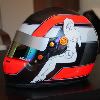Well, someone seems to be a bit cranky this morning... If everyone who doesn't agree with your vision of things keeps his thoughts to him/herself, there's really no point in any kind of discussion is there? You don't want to be contradicted? Don't come to a discussion forum.Tumbarello wrote:Balderdash! You have no way of knowing what "impression" the "other teams" were under, and don't pretend otherwise. In fact, you are making them out to be dimwits since the RB6 was cleared time and again even in light of more stringent testing that was carried out on it, so "the other teams" had every indication that the FIA will pass the RB7 of any wrong doing as long as said car passed the tests and measures in place.bot6 wrote:4) The other teams were apparently under the impression that the FIA would not turn a blind eye on this like last year
In future, I suggest you keep your "less biased summary" of threads to yourself.
You're right in saying that I have no way of knowing for sure what impression this or that team has of the rules. That's why I used the word "apparently", which implies what follows is a supposition.
But it is a supposition supported by the fact that no other team developed such a device during the winter, even though it was already used by RBR last year. However, the wing (and especially nose and pillar) bending on the RB6 was not quite as severe as that on the RB7. Last year only the sides of the wing bent downwards a little. This year, on top of that, the whole wing goes down, and in a much larger amount. And the endplates scrub the ground.





